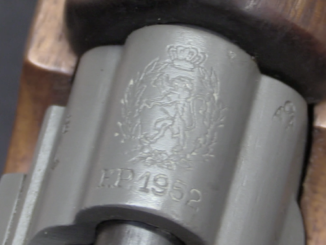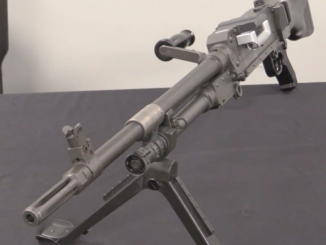In the wake of World War Two, much of Europe was awash in small arms – but there were still organizations looking to purchase new arms rather than use the available surplus. The Gemeentepolitie Amsterdam (Amsterdam Municipal Police), for example, formed a Submachine Gun and Carbine Brigade in 1948 to act as a response unit for situations beyond the scope of a typical police officer. They would use available British Sten guns for the SMG, but the only carbines readily available were leftover German K98ks. The Municipal Police opted instead to place an order for brand new carbines from FN. However, they only wanted 245, and FN was unwilling to make a special order for such a small quantity.
Instead, the Police piggybacked on a 1950 order for 20,000+ carbines by the Dutch East Indies Army. Two hundred additional guns were added for the Police, which differed only in their roll marks. These carbines were chambered for 8mm Mauser, with a “J” crest for Queen Juliana. They retained a bayonet lug, but bayonets were never used by the Police. They also retained the dual sling options form the East Indies pattern, but immediately upon receipt the Police armorers ground off the left-side wrist sling swivel, as it tended to interfere with a good shooting grip and was not necessary for municipal use. Many other Dutch law enforcement agencies also purchased Mausers around this time, but only 200 went to Amsterdam specifically.
Within only a few years, the use of carbines in 8mm Mauser began to be questioned. The recoil and muzzle blast form this cartridge in such a short barrel was punishing, and the municipal police really did not need such a powerful round for patrolling the city of Amsterdam (over penetration was a significant concern!). By 1965, all the police Mauser carbines were replaced with surplus American M1 Carbines, which were really far superior arms for the law enforcement role.




“a Submachine Gun and Carbine Brigade in 1948”
So much for the idea that SWAT Teams were invented in El Lay in the late Sixties/Early Seventies
And to go even further back, weren’t the German Police the only people in Das Reich allowed to carry submachine guns/machine pistols after the Kaiser War?
The interwar German national police included a corps called the “Barracks Police”, meaning a paramilitary force. Presumably, to crush major disorder. However, probably also using very destructive conventional army doctrine. Whereas SWAT was specifically about small-unit action, like an attack on a single building.
I have seen a painted illustration of a light Panzer in police service.
Yes, of course the German police had those weapons. At that time Germany did not have armed forces, the Federal Republic of Germany got its armed forces (the Bundeswehr) late 1955. So until that time, the police was the only force that could be used in situations where otherwise the army would have been used.
Yes, and German police had most of the same stuff a modern SWAT team has, including armored cars. Darryl Gates and LAPD were half a century late to the party.
I do not know about German but Austrian Sicherheitswache used 6 examples of Straßenpanzerwagen ADGZ https://de.wikipedia.org/wiki/Steyr_ADGZ
Ian did a piece on a much earlier team I had read about beforehand, formed by Col. Fairbairn in the 30s in Shanghai.
Dutch police will never patrol with carbines and/or sub-machine guns, they will only have pistols with them. Carbines and sub-machine guns will be kept at the police station, and will only be used in special circumstances. I don’t know how it is these days, but in the past the police needed special permission from the minister to use these guns.
Here is the Carbine in FNs operators manual. Page 25
http://www.nazarian.no/images/wep/24_FN98.pdf
Don’t know about that. I saw a statuesque blonde in a blue jumpsuit and body armor carrying an MP5 at Schipol several years ago. Might not have been a cop, I guess.
Blue jumpsuit? Bright blue beret? KMar military police on border control duty.
That was a member of the Koninklijke Marechaussee, or Royal Mounted Police. It is the fourth branch of our armed forces, next to the army, navy, and air force (the marines are part of the navy). The Marechaussee is responsible for border patrol, border checks (they will do the passport controls at Schiphol), they are the military police for all other branches, guard duties at the royal palaces and the parliament, and on request assist the normal national police. Together with normal police and marines, they also are part of special intervention teams for dangerous arrests, anti-terror operations etc.
As obscure speculation … what happens when you drill a few ports in the barrel … to lower gas pressure … like on suppressed weapons? Is that a practical way to reduce muzzle energy and over-penetration – on police weapon?
What you are describing is something like a Magna-port
I’m guessing that it’s further down the Barrel though?
You’d need some sort of metal barrel shroud to keep that sideways blast away from your hands and your colleagues, and to direct it forward.
Guns with muzzle brakes and muzzle ports are horrible things to be near. They’re far louder at the side and behind, compared with the same gun without the ports
You would be looking at serious hearing damage, and possibly also temporary stunning of yourself and colleagues, if you in close quarters,or beside a wall.
You are els looking at a horrible injury for anyone who gets hit by the high pressure jets of gas
Even with ordinary compressed air in industry (~100 PSI, rather than 10s of thousands of PSI), you have to be careful about the pressure forcing foreign substances through your skin
As pressures get higher (Normally with hydraulics rather than compressed air, but the principle is the same)
you risk getting foreign objects and substances into bundles of muscles. You don’t necessarily notice it, there’s not necessarily an obvious wound…
Infact, the wounds are often so insignificant looking that there are cards available for people who work with hydraulics, diesel fuel injection and high pressure gasses, to show to medical people, explaining that there is a real and very serious problem going on (usually called “hydraulic injection).
The danger is swelling within muscle bundles, killing the muscle and cutting off blood supply through the muscle and the area around it
Along with any toxic or allergic effects of whatever got forced in.
You are actually looking at very serious injuries, requiring lots of damaged tissue to be cut open to release swelling and lots of dead tissue, with probable infection developing in that.
The reason why you don’t get so much of that effect from the exhaust ports on gas operated guns, is because the gas has been expanded, and has cooled as the gas system has extracted energy from it.
It’s also lost a lot of heat and pressure, passing through the very fine bore barrel port and any additional tubing, to get to the gas system.
Keith,
I agree. The best thing you could do to this piece would be to fit a silencer to it.
“(…)Is that a practical way to reduce muzzle energy and over-penetration – on police weapon?”
Regarding 2nd issue, this might be achieved by using Frangible Ball ammunition. Only modification which might be required for non-automatic weapon was reworking sights.
As for 1st issue this can be done by using reduced charge cartridge. This would need reworking sights. There is not danger as long as there do not exist solely for reduced charge cartridges – at worst by loading “normal” load you will get unpleasant kick and hitting in other place that sight suggest.
Were there not millions of mauser 98k rifles distributed through Europe after the war? Seems odd to buy newly manufactures rifles.
I can imagine criminals being quite well armed back then, not all of the airdropped canisters full of guns for the resistence were ever reclaimed.
You are right, there was no shortage of guns on the black market in the 1950s and 60s. Older guys I used to shoot with in the 80s told me it was easy to buy pistols and even submachine guns back then. A friend of my father’s at university in the 40s had a Luger as a souvenir, they were could be commonly found then.
However, although criminals could obtain firearms with ease, they were reluctant to use them because of the fear of capital punishment. Throughout Western Europe, the 50s and 60s saw the gradual end of capital punishment. It ended in Britain in 1965. That had been a major deterrent to the use of guns by criminals, even when black market guns were plentiful. It is harder to get guns now, but criminals are far more prepared to use them, even to settle minor disputes.
At what point did FN start to broach through both sides of the breech collar inside the receiver ring?
Too bad they did produce the carbine in a 7.92x33K? That would have probably served them well in Amsterdam.
correction: “Too bad they DIDN’T produce…”
Totally agree that an 8mm rifle is over powered in a civilian urban setting. The M1 30 carbine was rapid fire, more rounds, and not dangerously overpowered for innocents.
So, your pals grab the sten guns and surround the house where the bank robbers are hiding. You’re ordered to watch the squad car and handed a mauser. That’s when you start thinking maybe you should have stayed and kept working in your uncles clog factory like mother wanted.
I agree that the 8mm Mauser (or 7.92mm as all British reference books call it) is overpowered for a police weapon, and definitely overpowered for a carbine with a 17 inch barrel. I realise the Dutch might have preferred not to use ex-Wehrmacht Kar98Ks for obvious reasons, but since they were very practical and to be had for free, they ought to have done so.
As to the tiny notch in the rear sight, which I can hardly see, I can only conclude that people had eyes like cats back in the day. Perhaps all the time we spend looking at screens these days really has ruined our eyes.
“I agree that the 8mm Mauser (or 7.92mm as all British reference books call it) is overpowered for a police weapon, and definitely overpowered for a carbine with a 17 inch barrel.(…)”
This choice is mind-boggling for me in that Kingdom of Netherlands earlier used 6,5 mm Mannlicher weapons https://surplused.com/index.php/2014/09/25/a-quick-and-dirty-guide-dutch-mannlichers/
which to my understanding should give less stout recoil in similar sized carbine
Daweo:
Yes, the 6.5mm carbines would have been ideal for the job the police wanted to do. But I wonder what state they were in after the war? But surely it would have been possible to find 200 decent examples?
This does answer the question of what carbine was stowed in Grijpstra and De Gier’s beat up Volkswagen in 1975, since Jan Willem Van de Wetering was never specific about guns.
I have an opportunity to purchase two of these, one is serial number 2 and the other is 88. Both have all matching serial numbers. What concerns me is the one that is serial number 2 has the W (Queen Wilhelmina) roll mark on the receiver not the J (Juliana). It is also lacking the ground off sling (it has no sling swivel in that area). Both are in excellent condition with the muzzle protectors intact and perfect. Can anyone tell me (for certain) if the first few off the line had the W roll mark? I am skeptical and feel it may be something other than what it is stated to be.
Thanks in advance